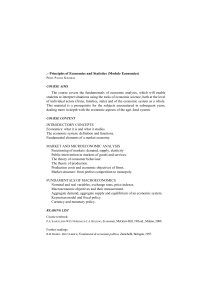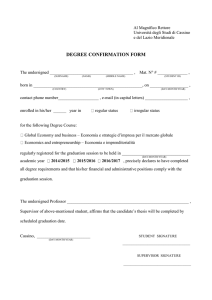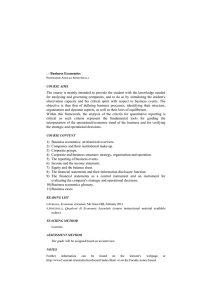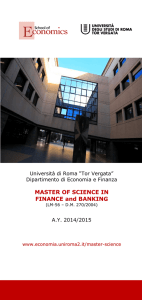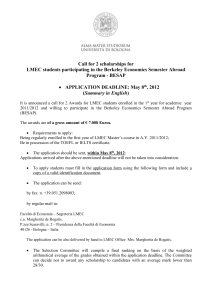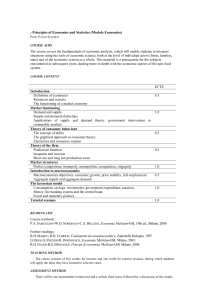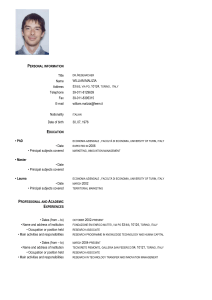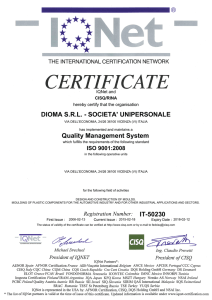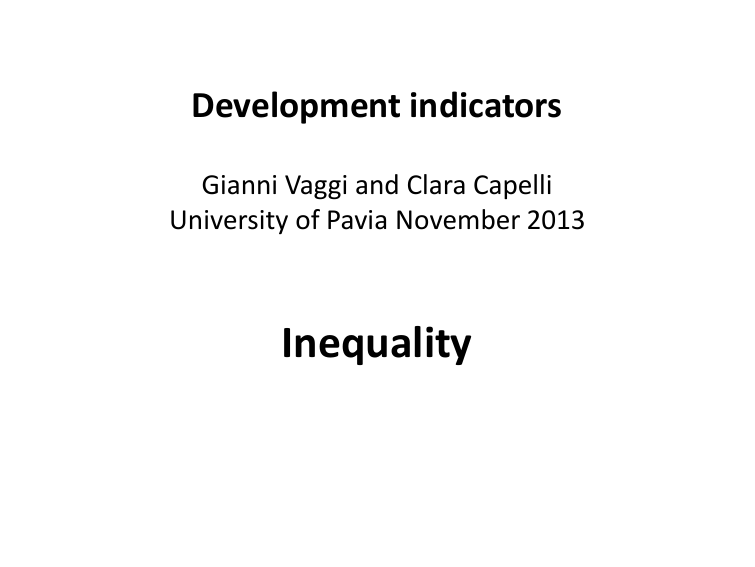
Development indicators
Gianni Vaggi and Clara Capelli
University of Pavia November 2013
Inequality
•
Relative concept;
•
Focus on distribution (wealth, income, opportunities, etc.);
•
Unlike efficiency (see Pareto), there is no widespread consensus on
the definition of equity/distributive justice;
•
Income distribution can be functional (i.e. wages, profits, rents)
or personal.
Economia dello Sviluppo
The personal distribution of income depends on:
•
Personal features and skills;
•
Personal position wrt to an economy’s productive structure;
•
Welfare schemes (the so-called "secondary personal distribution of
income)
Economia dello Sviluppo
The Lorenz Curve
•
Developed in 1905 by Max Lorenz;
•
Relates the cumulative proportion of income to the cumulative
proportion of individuals;
•
The x-axis records the cumulative proportion of individuals, ranked
by income level (from the poorest to the richest);
•
The y-axis records the income share for each proportion of
population.
Economia dello Sviluppo
Economia dello Sviluppo
Measuring Inequality
Inequality Trends
How to Draw a Lorenz Curve
Calculate the proportion of income belonging to each individual;
Calculate which proportion of total population each individual
represents;
Sort these individuals on the basis of the income they own;
Define the line of equidistributed income;
Plot the cumulative proportion of income against the cumulative
proportion of population.
Economia dello Sviluppo
The Gini Coefficient
How can we compare Lorenz Curves? An index allows for easier
comparisons.
•
Introduced by Corrado Gini in 1912 (Variability and Mutability);
•
Measures the inequality among values of a frequency distribution;
•
Ranges from 0 (perfect equality) to 1 (complete inequality);
•
It is equal to the area between the equality line and the Lorenz Curve,
divided by the area below the equality line;
Economia dello Sviluppo
Gini coefficients, 2008
Afghanistan
Argentina
Brazil
Colombia
China (2005)
Ghana (2006)
Egypt
India
Nigeria
Malaysia (2007)
Mozambique
Russia
Thailandia
Turkey
Venezuela (2006)
West Bank & Gaza (2007)
27.8
46.3
55.1
57.2
42.5
42.8
30.8
33.4
44.8
46.2
45.7
42.3
40.5
39.0
44.8
38.7
Source: WB Database
Economia dello Sviluppo
Economia dello Sviluppo
Economia dello Sviluppo
Economia dello Sviluppo
Kuznets Curve
Economia dello Sviluppo
Kuznets Curve/2
•
Industrialization and rural-urban migration lead to a rise in
inequality;
•
After a certain level of income, democracy and welfare schemes
allow for more equality;
Economia dello Sviluppo
Again on China & India, Brazil & Venezuela
Economia dello Sviluppo
Kuznets Curve: Criticisms
Fields (2001): other factors matter more than the stage of
development (history&geography, role of mining, access to land,
etc.);
Stiglitz (1996): East Asian Miracles shows that Kuznets’ story does
not hold;
Palma (2011): The real difference is made by what is appropriated
by the richest decile.
Economia dello Sviluppo
The Gini coefficient fell in 44 countries (out of 81 examined):
Source: WBI, 2012
Economia dello Sviluppo
Maddison, The World Economy. Historical Statistics (2003)
•
World inequality falls between 1950 and 1960 (post-war catching up
of Europe and Japan);
•
It then rises strongly until 1980 (rapid growth of developed
countries);
•
It then falls, mainly because of China.
Economia dello Sviluppo
Source: Maddison, 2003
Economia dello Sviluppo
Source: Maddison, 2003
Economia dello Sviluppo
Measuring Inequality
Inequality Trends
Bourguignon & Morrisson, Inequality Among World Citizens, 1820-1992 (2001):
•
World inequality (global Gini) increased by 30 percent, hitting 0.6;
•
•
This is mostly due to the "between" component;
A comparatively little difference was found between the world
distribution of the 1990s and in the 1950s;
Stabilizing effect of the "within" component.
•
Economia dello Sviluppo

